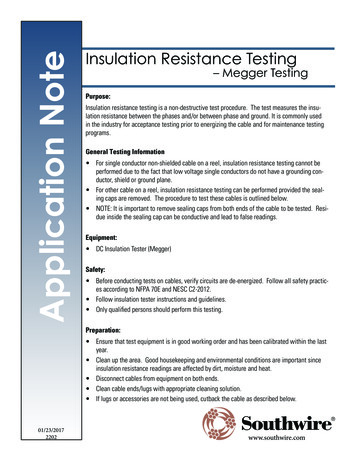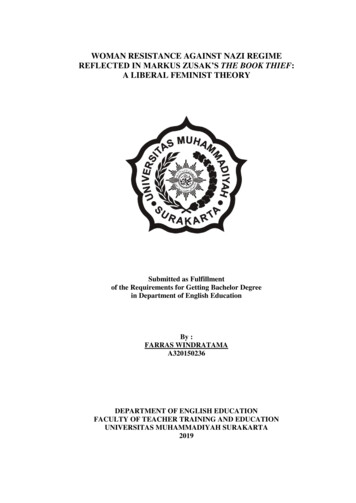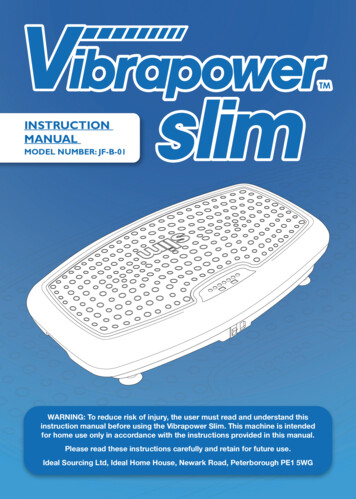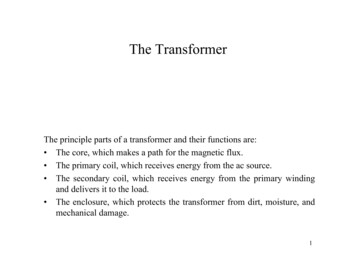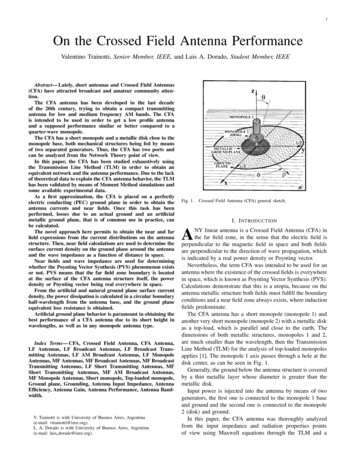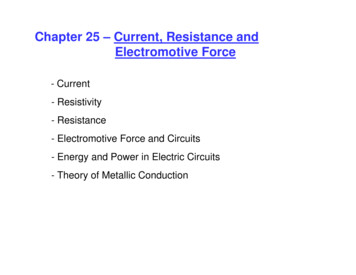
Transcription
Chapter 25 – Current, Resistance andElectromotive Force- Current- Resistivity- Resistance- Electromotive Force and Circuits- Energy and Power in Electric Circuits- Theory of Metallic Conduction
1. CurrentElectric current: charges in motion from one region to another.Electric circuit: conducting path that forms a closed loop in which chargesmove. In these circuits, energy is conveyed from one placeto another.Electrostatics: E 0 within a conductor Current (I) 0, but not all chargesare at rest, free electrons can move (v 106 m/s). Electrons are attracted to ions in material do not escape.Electron motion is random no net charge flowNon-electrostatic: E 0 inside conductor F q ECharged particle moving in vacuum steady acceleration // FCharged particle moving in a conductor collisions with “nearly” stationary massiveions in material change random motion of charged particles.Due to E, superposition of random motion of charge slow net motion (drift) ofcharged particles as a group in direction of F q E net current in conductor.Drift velocity (vd) 10-4 m/s (slow)
Direction of current flow:- In the absence of an external field,electrons move randomly in aconductor. If a field exists near theconductor, its force on the electronimposes a drift.- E does work on moving charges transfer of KE to the conductor throughcollisions with ions increase invibrational energy of ions increase T.- Much of W done by E goes into heatingthe conductor, not into accelerating chargesfaster and faster.Metal: moving charges –Ionized gas (plasma) or ionic solution:moving charges or –Semiconductor: electron hole (vacancy) conduction
- Positive charges would move with theelectric field, electrons move inopposition.- The motion of electrons in a wire isanalogous to water coursingthrough a river.Conventional current (I): directionin which there is a flow of positivecharge.This direction is not necessarilythe same as the direction in whichcharged particles are actuallymoving.Current:I dQdt- Current is not a vector! no single vector can describe motion along curvedpath.
Current units: 1 A 1 C/sCurrent (I) is the time rate of chargetransfer through a cross sectional area.The random component of each movingcharged particle’s motion averages tozero I in same direction as E.Current, Drift Velocity and Current Density:I dQ n q vd Adtn concentration of charged particlesCurrent Density (J): J nqvdvd drift velocityIJ n q vdAJ is a vector, describes how charges flow at a certain point.
Steady current (closed circuit): total charge in every segment of conductoris constant equal rate of flow of charge in and out of segment.Direct current: direction of current is always the same.Alternating current: current continuously changes direction.2. Resistivity(Intrinsic materialproperty)Ohm’s law J directly proportional to E.1 Ohm 1 Ω V/AResistivity: ρ EUnits: Ω m (V/m)/(A/m2) (V/A)Jm
Conductivity: 1/ρMetals: good electrical and thermal conductors.Very large difference in conductivity of metals vs.insulators possible to confine electric currents.Semiconductors: intermediate resistivity betweenmetal & insulator.Resistivity and Temperature:ρ (T ) ρ 0 [1 α (T T0 )]α temperature coefficient of resistivityMetal: ρ increases with TSemiconductor: ρ decreases with TSuperconductor: ρ first decreases smoothly with decreasingT and becomes zero Tc (critical T)Highest Tc 233 K (2009) Ta5Ba4Ca2Cu10Ox
3. Resistance E ρ JOhm’s law ρ constantCurrent direction: from higher V end tolower V end. Follows E direction,independent of sign of moving charges.- As the current flows through a potentialdifference, electric potential energy islost. This energy is transferred to theions of conducting material duringcollisions.
I J AV E LE R resistanceVI ρ J ρLAResistance:V I R V ρ LAV ρ LR IAOhm’s law (conductors)Units: Ohm Ω 1 V/AR (T ) R0 [1 α (T T0 )]I
Resistor: circuit device with a fixed Rbetween its ends.Ex: 5.7 kΩ green (5) violet (7) red multiplier (100)Current-voltage curvesMetal
4. Electromotive Force and Circuits- No steady motion of charge in incompletecircuit.Electromotive Force (emf)- In an electric circuit there should be adevice that acts like the water pump in afountain source of emf.- In this device, the charge travels “uphill”from lower to higher V (opposite to normalconductor) due to the emf force.- emf is not a force but energy/unit chargeUnits: 1 V 1 J/C- emf device convert energy (mechanical,chemical, thermal) into electric potentialenergy and transfer it to circuit.
- Ideal emf device maintains aconstant potential differencebetween its terminals, independentof I.Ideal diagram of “open” circuit Electric force: Fe qENon electrostatic force: Fnmaintains potential difference betweenterminals. If Fn 0 charge will flowbetween terminals until Vab 0Wn qεdisplacement opposite toFe potential energyIncreases by q·VabWn E qε K U U a U b q (Va Vb )Vab εIdeal source of emf (Fe Fn)Total work on q 0
Vab ε I R- When a positive charge q flows arounda circuit, the potential rise ε as it passesthrough the ideal source is equal to thepotential drop Vab as it passes throughreminder of circuit.-The current is same at every point of acircuit, even if wire thickness different atdifferent points of circuit. Charge isconserved and cannot be accumulated incircuit.Ideal diagram of “closed” circuit
Internal resistance- In a battery, you only get 12 V when it isn’tconnected.- Making connections allows electrons to flow, butinternal resistance within battery deliversincrementally less than 12 V.- The potential difference across a real source isnot equal to emf. Charge moving through the materialof the source encounters internal resistance (r).Terminal voltage:Vab ε IrSource with internal resistance- For a real source, Vab ε (emf) only if no current flows through source.I εR r
- The meters do not disturb the circuit in which they are connected.- Voltmeter infinite resistance I V/ R I 0 (measures V)- Ammeter zero resistance V I R 0 (measures I)
Potential changes around a circuit- The net change in potential energy for a charge q making a round triparound a complete circuit must be zero.- Local differences in potentialoccur.
5. Energy and Power in CircuitsPower: rate at which energy is delivered to orextracted from a circuit element.P Vab I (Va – Vb) IUnits: 1 Watt W V A (J/C) (C/s) J/sPotential Input to a Pure ResistanceVab2P Vab I I R R2Rate of transfer of electric potential energy into thecircuit (Va Vb) energy dissipated (heat) in resistorat a rate I2 R.Potential Output of a sourceP Vab I (ε Ir ) I ε I I 2 rε I rate at which the emf source convertsnonelectrical to electrical energy.I2 r rate at which electric energy is dissipated at the internal resistance of source.
Potential Output of a sourcePotential Input to a sourceP Vab I (ε Ir ) I ε I I 2 rConversion of electrical energy into non-electricalenergy in the upper source at a rate ε I.I2 r rate of dissipation of energy.Lower source pushing current upward throughupper source.
6. Theory of Metallic Conduction- If no E free e- move in straight lines between collisions with ions random velocities, in average, no net displacement.- If E e- path curves due to acceleration caused by Fe drift speed.Mean free time (τ): average time between collisions.Analogy to motion of e- with E.
Eρ J J n q vd v v0 aτ F qEa m mqτ vavg a τ E vdm nq 2τ J n q vd EmEmmρ 2 2J q nτ e nτ
Current units: 1 A 1 C/s Current, Drift Velocity and Current Density: Current (I) is the time rate of charge transfer through a cross sectional area. The random component of each moving charged particle's motion averages to zero I in same direction as E. n concentration of charged particles vd drift velocity nqv A dt dQ I d J nq vd



